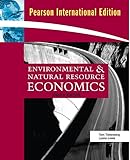Environmental & natural resource economics / Tom Tietenberg, Lynne Lewis.
Series: Pearson International EditionPublication details: Boston : Pearson Addison Wesley, c2009.Edition: 8th editionDescription: xxviii, 660 p. : ill. ; 24 cmISBN:- 9780321560469
- Environmental and natural resource economics
- 333.7 22
- 333.7 1
| Item type | Current library | Call number | Copy number | Status | Date due | Barcode |
|---|---|---|---|---|---|---|
 Book Open Access
Book Open Access
|
Natural Resources and Environmental Sciences Library | 333.7 TIE (Browse shelf(Opens below)) | 1 | Available | 0015502 | |
 Book Open Access
Book Open Access
|
Natural Resources and Environmental Sciences Library | 333.7 TIE (Browse shelf(Opens below)) | 2 | Available | 0012272 | |
 Book Open Access
Book Open Access
|
Natural Resources and Environmental Sciences Library | 333.7 TIE (Browse shelf(Opens below)) | 3 | Available | 00011509 | |
 Book Open Access
Book Open Access
|
Natural Resources and Environmental Sciences Library | 333.7 TIE (Browse shelf(Opens below)) | 4 | Available | 0015501 | |
 Book Open Access
Book Open Access
|
Natural Resources and Environmental Sciences Library | 333.7 TIE (Browse shelf(Opens below)) | 5 | Available | 00011494 | |
 Book Open Access
Book Open Access
|
Natural Resources and Environmental Sciences Library | 333.7TIE (Browse shelf(Opens below)) | 6 | Available | 0015503 |
Table of Contents
Chapter 1. Visions of the Future
Introduction
Future Environmental Challenges
Meeting the Challenges
How Will Societies Respond?
The Role of Economics
The Road Ahead
Chapter 2. Valuing the Environment: Concepts
Introduction
The Human Environment Relationship
Normative Criteria for Decision-Making
Finding the Optimal Outcome
Applying the Concepts
Appendix:The Simple Mathematics of Dynamic Efficiency
Chapter 3. Valuing the Environment: Methods
Introduction
Why Value the Environment?
Valuing Benefits
Cost-Effectiveness Analysis
Impact Analysis
Chapter 4. Property Rights, Externalities, and Environmental Problems
Introduction
Property Rights
Externalities as a Source of Market Failure
Improperly Designed Property Rights Systems
Public Goods
Imperfect Market Structures
Divergence of Social and Private Discount Rates
Government Failure
The Pursuit of Efficiency
An Efficient Role for Government
Chapter 5. Dynamic Efficiency and Sustainable Development
Introduction
A Two-Period Model
Defining Intertemporal Fairness
Are Efficient Allocations Fair?
Applying the Sustainability Criterion
Implications for Environmental Policy
Appendix:The Mathematics of the Two-Period Model
Chapter 6. The Population Problem
Introduction
Historical Perspective
Effects of Population Growth on Economic Development
The Population/Environment Connection
Effects of Economic Development on Population Growth
The Economic Approach to Population Control
Urbanization
A Note on Using GIS to Map Population Data
Chapter 7. The Allocation of Depletable and Renewable Resources: An Overview
Introduction
A Resource Taxonomy
Efficient Intertemporal Allocations
Market Allocations
Appendix:Extensions of the Basic Depletable Resource Model
Chapter 8. Energy: The Transition from Depletable to Renewable Resources
Introduction
Natural Gas: Price Controls
Oil: The Cartel Problem
Fossil Fuels: National Security and Climate Considerations
The Other Depletable Sources: Unconventional Oil, Coal and Nuclear
Electricity
Energy Efficiency
Transitioning to Renewables
Chapter 9. Recyclable Resources: Minerals, Paper, Bottles, and E-Waste
Introduction
An Efficient Allocation of Recyclable Resources
Factors Mitigating Resource Scarcity
Market Imperfections
Chapter 10. Replenishable but Depletable Resources: Water
Introduction
The Potential for Water Scarcity
The Efficient Allocation of Scarce Water
The Current Allocation System
Potential Remedies
GIS and Water Resources
Chapter 11. Land
Introduction
The Economics of Land Allocation
Sources of Inefficient Use and Conversion
Special Problems in Developing Countries
Innovative Market-Based Policy Remedies
Chapter 12. Reproducible Private-Property Resources: Agriculture
Introduction
Global Scarcity
Formulating the Global Scarcity Hypothesis
Testing the Hypothesis
The Role of Agricultural Policies
A Summing Up
Distribution of Food Resources
Feast and Famine Cycles
Chapter 13. Storable, Renewable Resources: Forests
Introduction
Characterizing Forest Harvesting Decisions
Sources of Inefficiency
Poverty and Debt
Sustainable Forestry
Public Policy
Appendix:The Harvesting Decision: Forests
Chapter 14. Common-Pool Resources: Fisheries and Other Commercially Valuable Species
Introduction
Efficient Allocations
Appropriability and Market Solutions
Public Policy Toward Fisheries
Appendix:The Harvesting Decision: Fisheries
Chapter 15. Economics of Pollution Control: An Overview
Introduction
A Pollutant Taxonomy
Defining the Efficient Allocation of Pollution
Market Allocation of Pollution
Efficient Policy Responses
Cost-Effective Policies for Uniformly Mixed Fund Pollutants
Cost-Effective Policies for Nonuniformly Mixed Surface Pollutants
Other Policy Dimensions
Appendix:The Simple Mathematics of Cost-Effective Pollution Control
Chapter 16. Stationary-Source Local Air Pollution
Introduction
Conventional Pollutants
Innovative Approaches
Chapter 17. Regional and Global Air Pollutants: Acid Rain and Atmospheric Modification
Introduction
Regional Pollutants
Global Pollutant
Chapter 18. Mobile-Source Air Pollution
Introduction
The Economics of Mobile-Source Pollution
Policy Toward Mobile Sources
An Economic and Political Assessment
Chapter 19. Water Pollution
Introduction
Nature of Water Pollution Problems
Traditional Water Pollution Control Policy
Efficiency and Cost-Effectiveness
Chapter 20. Toxic Substances
Introduction
Market Allocations and Toxic Substances
Current Policy
An Assessment of the Legal Remedies
Chapter 21. Environmental Justice
Introduction
The Incidence of Hazardous Waste Siting Decisions
The Incidence of Pollution Control Costs: Individual Industries
The Generation of Pollutants
The Incidence on Households
Implications for Policy
Chapter 22. Development, Poverty, and the Environment
Introduction
The Growth Process
Energy
Outlook for the Near Future
The Growth-Development Relationship
Growth and Poverty: The Industrialized Nations
Poverty in the Less Industrialized Nations
Chapter 23. The Quest for Sustainable Development
Introduction
Sustainability of Development
Managing the Transition
Chapter 24. Visions of the Future Revisited
Addressing the Issues
Includes bibliographical references and indexes
.


There are no comments on this title.